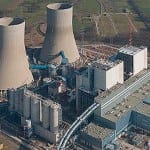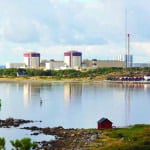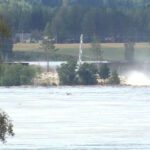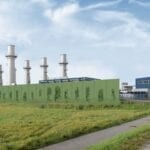Numerous energy facilities were afflicted by the major flooding event that inundated parts of Europe last week, and at least one major power generator has said the damage will likely mount into a “mid-double-digit million euro sum.”
The flooding, which was caused by a cold, low-pressure area dubbed “Bernd,” crawled slowly across the continent over two days on July 15 and July 16, dumping unprecedented volumes of precipitation in some areas, and causing rapid overflows in rivers and sewage systems.
Tief #Bernd brachte regional enorme Niederschläge, die leider oft katastrophale Folgen hatten, vielen Menschen das Leben kosteten. Der #DWD hat eine erste Auswertung der Niederschlagsmengen grafisch dargestellt. Die ausführliche klimatologischen Analyse folgt nächste Woche. /kis pic.twitter.com/VtfF34xApi
— DWD (@DWD_presse) July 16, 2021
A translation of the tweet reads: “Deep #Bernd brought enormous regional rainfall, which unfortunately often had catastrophic consequences and cost many people their lives. The [German Weather Service] has graphically presented an initial evaluation of the amount of precipitation. The detailed climatological analysis will follow next week.”
As of July 19, the reported death toll was 150, but nearly 1,300 people were missing or unaccounted for in Germany. The worst-hit regions were Rhineland-Palatinate, a state in southwestern Germany, and neighboring North Rhine-Westphalia (NRW) to the north. The flooding also affected regions in Germany’s south and east, parts of Belgium, and parts of the Netherlands and Switzerland.
In NRW, Germany’s most populous state and its energy and industrial powerhouse, 25 cities and districts were affected. Last week, the state marked record runoff conditions at numerous gauges, putting pressure on the state’s 64 dams. In Hagen, which is located where the Lenne and Volme Rivers meet the Ruhr River, 240 liters of precipitation per square meter fell over two days. “In normal years, the NRW average is 80 liters over the whole of July,” Bernd Mehlig, head of the flood information service of the state’s Office for Nature, Environment, and Consumer Protection, said on Friday.
The disaster prompted increased vigilance at several facilities in affected regions. During the event, Engie Electrabel ramped up its watch over the Tihange nuclear power plant on the Meuse River in Belgium, though it said the risk of flooding remained under control. Wind Europe, a trade group, reported that wind turbines “remained largely unaffected and helped to ensure a steady electric supply.”
Other facilities fared much worse. Belgian transmission system operator Elia said that after two days of floodwaters preventing access to the Pepinster substation in Liege, an eventual safe entry revealed “extensive” damage.
#Update | After 2 days of #floodwater preventing us from accessing the #Pepinster station, we were able to safely enter this afternoon. The damage is extensive. Our teams are preparing reparations. Meanwhile, we work on a temporary solution in consultation with the local DSO. pic.twitter.com/Evo8MDsssp
— Elia (@eliacorporate) July 16, 2021
RWE Provides a Snapshot of Damage
Considerable damage was also reported in NRW, a state that produces and consumes 30% of Germany’s power, and where 53% of German lignite is mined. In 2020, NRW hosted 29,770 MW of installed capacity. At least one major generator, RWE, on Saturday confirmed the floods imperiled many of its power stations. An initial evaluation suggested the damage has amounted to “a mid-double-digit million euro sum,” it said.
Nearly all its run-of-river power plants on the Mosel, Saar, and Ruhr rivers in the Eifel region in western Germany (straddling the NRW and Rhineland-Palatinate states and extending into Belgium and Luxembourg) went offline during the event. The 11-MW Linne hydropower plant on the Limburg River in the Netherlands also went out of service. Only two plants, the 10-MW Baldeney and the 420-kW Unkelmühle were still operating. As of Tuesday, however, all but 14 MW of RWE’s combined 400-MW run-of-river capacity had restarted operations, following an effort that involved pumping, securing, and clean up, a spokesperson said.
A “flood wave” from the Maas River, meanwhile, surged to peak on Friday night, imperiling the 1,304-MW Claus gas-fired power plant near Maasbracht in the Netherlands. RWE said, however, that dikes withstood the surge and the plant continues to operate.
Perhaps hardest hit were RWE’s Inden open-cast mine in the Rhenish lignite mining area, and its connected 2-GW Weisweiler power station in Eschweiler. RWE operates three large opencast mines, Hambach, which produces 40 million tonnes of lignite a year; Garzweiler, which produces 30 million tonnes a year; and Inden, which produces 20 million tonnes. All lay within the Rhenish lignite mining region, a 2,500-square-kilometer area between Aachen and Cologne, NRW’s biggest city. The Garzweiler and Hambach mines are “stable,” RWE reported, and the 3.1-GW Niederaußem and 4.2-GW Neurath lignite power plants continue to produce power.
The Inden mine, however, was “massively affected” when waters of the Inde River flooded a dam near the village of Lamersdorf and subsequently entered the open-cast mine on Thursday morning. At least one worker, a 58-year-old contractor, has been reported missing. Work to stabilize the mine began on Saturday “due to falling water levels and extensive safety measures.” The Weisweiler power station has also begun running at reduced capacity, supplied by the existing bunker reserve. “How long it will take to fully restore operations of the open-cast mine and the Weisweiler power station is currently being evaluated,” RWE said.
A video posted by Twitter user @DanniPilger on July 15 reportedly shows the extent of the flooding at RWE’s Inden open-cast mine in Eschweiler.
#tagebau #inden von #rwe geflutet #KohleArmin #LaschetLuegt #KlimakriseISTjetzt #LaschetVerhindern #LaschetWelle pic.twitter.com/61Su9wcyLs
— #Hambi bleibt (@DanniPilger) July 15, 2021
Climate Action Imminent
As of Wednesday, efforts continued in disaster-struck regions, though leaders acknowledged reconstruction could take “months, even years.” The German Weather Service, meanwhile, warned progressive climate change could lead to more extreme events. “Climate change shows a first significant tipping point in the climate system: the weakening jet stream,” Guido Halbig, head of the agency’s Essen branch. “It is the decisive control system for the high and low-pressure areas in our latitudes and thus for our weather. If the high-altitude current weakens or remains in one place, the result is a drought summer like 2018 to 2020 or dramatic rainfall like these days,” he said.
NRW Prime Minister Armin Laschet, a candidate of Chancellor Angela Merkel’s center-right Union bloc who is running in the nation’s Sept. 26 election, in a speech told citizens the state must prioritize climate change resilience. “We have to build dams, retention basins, water reservoirs, renaturalize areas—protection not only on the Rhine, but also on the large and many small rivers throughout the country,” he said.
—Sonal Patel is a POWER senior associate editor (@sonalcpatel, @POWERmagazine)










